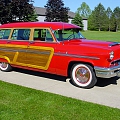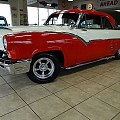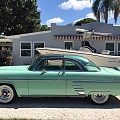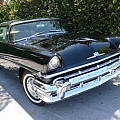Ford created its Mercury line-up in 1939 to fill the medium-priced gap between the Ford DeLuxe and its Lincoln-Zephyr models. The first Mercury was one of the first cars styled in Ford’s new in-house design studio and the first developed from a full-scale clay mock-up.
It was at this time Ford established Lincoln and Mercury as separate divisions in the Ford Motor Company. The Mercury proved to be a huge success and two series of cars began production under the marquis but a third was soon added. Within the Custom Monterey and Montclair series was a complete line-up of models including convertibles and station wagons. As well as numerous engine options air conditioning was offered as an option for the first time but few were sold.
Although now separate divisions Mercury models still incorporated many of the Lincoln styling cues and design features. Gone were the soft rounded edges of the previous models. For the Monterey the bodylines were straight and added creases and the hint of a tail fin created a trimmer more modern jet-inspired appearance. A revamped bumper and grille tidied up the front end while a set of new wraparound taillights brought up the rear.
The real news for Mercury was hidden under the hood. Taking up residence there was the company’s first overhead valve V-8 engine. Replacing the fabled ‘flathead’ the new Y-block eight boasted “Twin Tornado” combustion chambers aluminum pistons and a Holley 4v carburetor. It was rated at 161 h.p. which was 36 more than the previous engine and 31 more than Ford’s smaller displacement V-8. In addition to the power boost the ’54 Mercs were better handlers than the outgoing models thanks to the introduction of a new ball joint front suspension. Power brakes were also beefed up to keep pace with the added horses. Those features combined with a Merc-O-Matic transmission which was essentially Ford's Borg-Warner designed 3-speed automatic that used an integrated torque converter and planetary gearset resulting in a smooth shift without an interruption in torque from the engine as well as power steering helped to round out an altogether pleasurable driving experience.
Mercury’s sole station wagon was the Monterey. The three row/eight passenger woody was like its Ford counterpart actually woodless. Real wood exterior trim was phased-out by all wagon manufacturers in the early 50’s. Ford/Mercury decided that their customers liked the look of wood but not the upkeep. Therefore all ’54 Monterey station wagons wore wood-like trim fiberglass strips surrounding decal inserts. Frenched headlights imitation hood scoop full-width chromed bumpers bullet-style bumper guards red painted steel wheels chromed center caps and trim rings wide whitewall tires aircraft-style lever controls for heater/defroster and ventilation controls rare windshield washer fluid container on firewall Frigiking air conditioning 110 MPH speedometer center dash grille in-dash clock and push button radio round out the long list of features that make the Monterey an enjoyable and stylish classic piece of '50's Americana.
Priced at $2776 the Monterey wagon sold 11656 units. Overall Mercury sales sagged for the model year (to 259305) yet their rank among automakers improved from 8th to 7th place industry-wide – ahead of Dodge and behind Pontiac.
The example here is in fantastic condition and appears to be mostly original. Having just completed a full mechanical service as needed it is ready for the next enthusiast to enjoy.
 1953 Mercury Monterey Station Wagon Woodie Woody OVERDRIVE!!! OUTSTANDING!!!!
1953 Mercury Monterey Station Wagon Woodie Woody OVERDRIVE!!! OUTSTANDING!!!!
 SUPER COOL 1953 MERCURY MONTEREY ((FLAT HEAD V8)) LEATHER FORD LINCOLN 50 51 52
SUPER COOL 1953 MERCURY MONTEREY ((FLAT HEAD V8)) LEATHER FORD LINCOLN 50 51 52
 1954 MERCURY MONTEREY SUN VALLEY (GLASS ROOF) FORD
1954 MERCURY MONTEREY SUN VALLEY (GLASS ROOF) FORD
 1956 Mercury Monterey similar to montclair ford fairline 1955 1957 Belair tbird
1956 Mercury Monterey similar to montclair ford fairline 1955 1957 Belair tbird